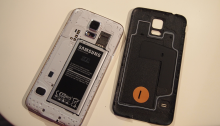Software and features
+++++ download booster only works with HTTP 1.1 and file downloads larger than 30mbs. It utilises your 4G and Wifi connection to increase your bandwidth. Generally speaking, that’s saying 1. the server has to support it 2. the file downloaded has to be larger than 30 megabytes.
The file is possibly split into two chunks, just like how Flashget works. The speed boost under our own testing was quite significant but just be careful because it WILL burn through your data plan.
At least you’ll have the choice of disabling it when you don’t want to use it.
+++ floating toolbar, what Samsung calls Toolbox, is a really handy addition. It adds a floating icon to the home screen and you’re free to place it anywhere you like, just like a Facebook chathead. Tap it, and it’ll extend a bar where favourite apps and functions can be placed as a shortcut.
+++ Magazine UX, powered by Flipboard, looks like it’s here to stay and makes its case on the S5 as well now. Again, hello Blinkfeed! It turns out to be a competent news aggregator, for those who need them.
+ a me-too fingerprint scanner, though sadly one that does not perform intuitively enough. It’s a combination of poor implementation and a thoughtless tutorial that prevented is ascension to greatness.
The problem in the first place would seem that every user would naturally be using the swipe scanner incorrectly. The tutorial has animations and pictures that illustrate a straight pointed thumb, swiping downward on the Home button. But then when it comes to real world usage, users would not likely be swiping their thumbs while keeping them straight. Some may attempt to do it all with a single hand, and even those who use both hands are not guaranteed to be holding their thumbs straight. It’s just human nature to be lazy- some call it “convenience”.
If the tutorial had taught the user to register for the fingerprint at a natural angle, things would be very different. Because that’s exactly what i tried- I registered my thumb at a slight angle- and the success rate was greatly increased from around 50% to around 90%- and this is for on-handed unlock.
The second problem is of course their choice of scanner. While swipe scanners are extremely common, nothing will beat Apple’s snapshot implementation where the Home button detects touch (with its metallic ring around the button) then proceeds to take a few high resolution photos of its user’s print.
Think what such an implementation could mean on the S5.
+ not advertised by Samsung, but there are a few battery-saving features from Lucidlogix baked into the OS (unsure at what level). There’s GameXtend, which supposedly increases game time, WebXtend which extends web browsing time and NavXtend (unsure if this is integrated) and they’re collectively know as PowerXtend. A bunch of clever algorithms that saves battery usage by 20 or so percent.
– the entire Settings page has been tweaked. Settings are still organised into their own sections but are no longer separated into tabs. Instead, they’re sprawled across one single page but into collapsible / expandable sections.
This, to me, feels like a rather confusing presentation especially considering how many extra items have been added by Samsung. There is a Search feature accessible from the top of the Settings page, which is a necessary (and traditional) addition but with a good UI design, it would not have to be there.
– dedicated heart rate sensor on the back, but is it necessary? Apple can accomplish this with its camera and flash alone.
Furthermore, its integration with S-Health has plenty room for improvement i.e. it doesn’t tell you what your heart rate means.
– S-Health does not receive a complete set of data from the Gear Fit. Yes you may receive an achievement for walking 10,000 steps on your Gear Fit, but S-Health does not report any of this at all.
– S-Health is felt sluggish on the phone for some unknown reason


































You must be logged in to post a comment.